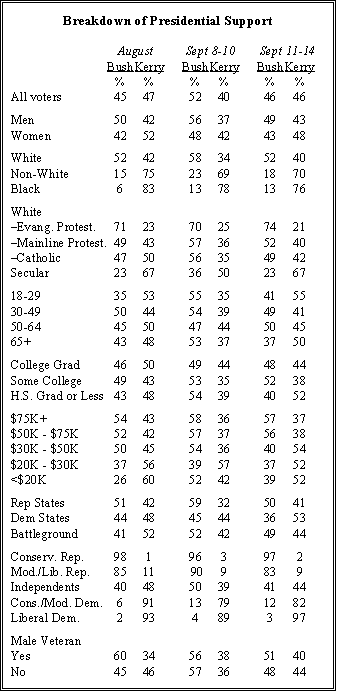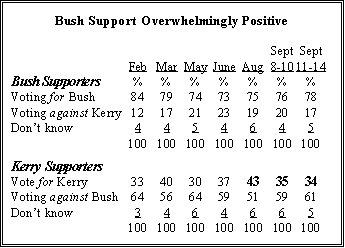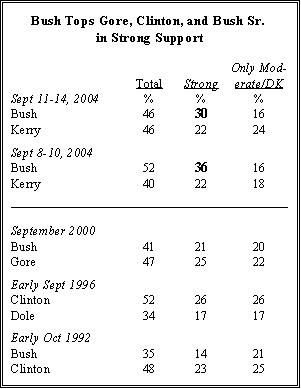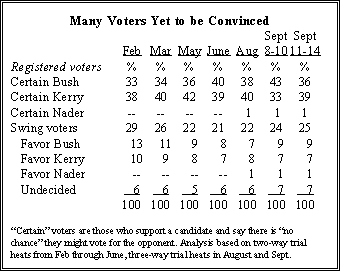
John Kerry’s gains in recent days have helped to bring him back into contention for the support of key voting blocs and to restore his lead among groups that had favored him when the race was deadlocked throughout the summer. But President Bush continues to enjoy a strong advantage among his base supporters. Significantly, the president also made gains in the battleground states since his convention and has not lost that support in the second wave of September polling.
In the aftermath of the Democratic convention in early August, Kerry led among women, young voters, as well as low-income voters. But during August, many of these advantages were wiped out. The Democrat dropped 18 points among voters making less than $20,000 a year, and 17 points among young people age 18-29. But in polling over the past several days, Kerry has regained his lead in all of these groups and now holds a lead among those age 65 and older.
A similar seesaw pattern occurred among two contested constituencies. After the Democratic convention, Kerry led by eight points among independent voters and had battled Bush to a draw among white Catholics. In the aftermath of the Republican convention, Kerry trailed Bush by 12 points among independents and by 21 points among white Catholics. But he has now drawn even among independents and trails the president by only seven points among Catholics.
By contrast, President Bush has maintained a strong lead among some of his key base constituencies. After the Democratic convention, he led Kerry among white men by 18 percentage points, an advantage that ballooned to 30 points shortly after the Republican convention. Even with Kerry’s recent gains, the president still has a 19 point-lead in this group. Similarly, Bush’s advantage among upper-income voters is larger today than it was after the Democratic convention.
Among white evangelical Protestants, another important segment of Bush’s base, the events of the past month have had little impact. Bush led by 48 points in early August, by 45 points after the Republican convention, and by 53 points today (74% to 21%).
But the survey suggests that partisan battling over the military service records of Bush and Kerry has not helped the president’s standing among male military veterans. Just after the Democratic convention, Pew’s poll found Bush leading Kerry by a margin of 60% to 34% among veterans. In the days following the Republican convention, where Kerry’s qualifications to be commander-in-chief were questioned by many speakers, Bush’s lead among veterans was slightly narrower (56% to 38%). In the most recent polling, it has slipped to 51%-40%.

Kerry’s Support Still Negative
Throughout the campaign, Kerry’s support has been more anti-Bush than pro-Kerry, while Bush’s voters have been far more positive about his candidacy than negative about Kerry’s. In the aftermath of the Democratic convention in early August, Kerry registered an uptick in the percentage of his voters who said they are voting for him, but that shift has not lasted. Last month 43% of Kerry supporters said they mainly were voting for him, while 51% said they were mainly were voting against President Bush. In the current poll both in early and later interviewing negative voters outnumber positive voters by a bigger margin than in August.

By contrast, the overwhelming majority of Bush voters continue to say that their vote is mostly a vote for the president (78% in the most recent interviewing) rather than against Kerry (17%), a result essentially unchanged from the August poll.
Even with some erosion of support in the second wave of September interviewing, Bush continues to command high levels of strong support: 30% say they support him strongly, down from 36% in the first part of the field period. His current level of strong support exceeds the level of intense support that Bill Clinton had at the same point in 1996 (26%), or that Clinton had against Bush’s father in October 1992 (23%). By contrast, fewer of Kerry’s voters say they strongly favor him 22% now, down from 28% in the August survey following the Democratic convention.
More Swing Voters
The survey finds a significant number of voters are still not certain about their choice. The percentage of registered voters who fall into the category of “swing voters” those who only lean to one candidate, those who say they might change their mind, and those who are completely undecided is slightly higher in the most recent interviewing (25%) than it was throughout the late spring and early summer (21-22%).

In the initial wave of polling (Sept. 8-10), Bush held an advantage among voters who are certain about their choice, having moved from 38% to 43% since the August poll. At the same time, the number of certain Kerry voters dropped from 40% in August to just 33% in the Sept. 8-10 survey. But Kerry has now regained most of the certain support he had lost (39% say they are sure to vote for him), while Bush’s certain support has dropped from 43% to 36%.